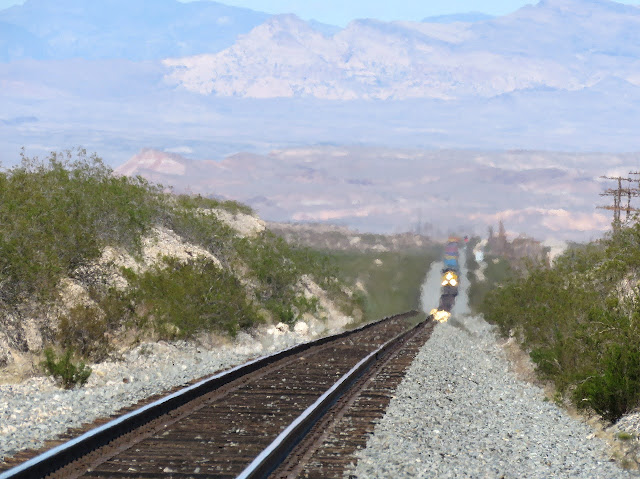When traveling to Georgia from the Northeast via Amtrak one has two options. You can travel directly via Train 19,
Amtrak's Crescent which leaves Washington DC a little after 5PM and travels mostly overnight arriving in Georgia at about sunrise. However there is a second option that involves catching the earlier Train 79,
The Carolinian, which departs WAS around 11am and travels via the
RF&P, the
CSX A-Line and NS H-Line before transferring to Train 19 in Greensboro, NC after a short 6 hour layover.
This route has the added benefit of having a reverse railfan window on Train 79 so you can do more than stare out the window aimlessly and on this trip I was determined to take advantage of it despite the poor light conditions and overcast skies. For those of you scared of a little layover Greensboro has a somewhat happening downtown with a variety of non-fast food eating establishments and one of the
best train stations in the Region that was re-opened in 2005 to replace an Amshack that was located away from downtown opposite a freight yard.
Normally if T79 is running on time it will meet the westbound evening Piedmont train across the platform, but on this trip there was a bit of a hiccup. Around 9am a morning Piedmont train struck a low-bow trailer that had become wedged on a grade crossing causing a spectacular derailment and completely closing the H-Line. Fortunately Amtrak was able to respond by terminating that day's Train 80 at Grensboro, Bussing the passengers to Rocky Mount, NC where they would meet my Train 79 and we would perform a little swap. The northbound passengers would take Train 79's set and we would bus past the derailment site and meet Train 80's set at Greensboro that would load up and continue south to Charlotte. Since my destination for this leg of the journey was in fact Greensboro I would be able to enjoy the re-training procedure as a spectator instead of a participant.
At the end of the day my Train 79 arrived at Rocky Mount about 30 minutes late mostly due to a police action way back in DC. The buses for folks using Train 79 past Greensboro went express right from Rocky Mount and we arrived at 7:30, 30 minutes late. So on what was my first Amtrak bustitution I ended up losing a total of 0 minutes.
Anyway. most of the 300 odd photos I took on this trip were out the back of Train 79 as it traveled on the CSX RF&P and North End subdivision. They are grainy and consist mostly of signaling so I won't really bother to showcase them here, but if you are at all interested in what these main lines look like feel free to check out the Ma href="http://acm.jhu.edu/~sthurmovik/Railpics/10-05-15_GEORGIA_SENIC_ROUTE/-Thumbnails.html">entire collection here. The list is in chronological order starting in DC and cover most of the signals, interlockings and bridges except for a stretch between RO and Springfield-Franconia on the RF&P.
So, let's see what we have here. A year ago MARC's old GP40-2WH's were still queen of the roost as the deliveries of MP36's were taking place. Here is #60 at Baltimore Penn Station.
After the trip down the NEC and power change at Washington Train 79
proceeds southbound here emerging from the First Street tunnels which
run under Capitol Hill.
Our train crosses the Potomac River on
the Long Bridge which was built in 1903. The bridge still features its PRR catenary supports and cross spans as well as the feeder cables for what was electrified freight service into Potomac Yard. The draw span on this bridge no longer operates.
At LORTON intelrocking, where Amtrak's AutoTrain accesses its
northern terminal off of the RF&P Main Line, I noticed that the northbound mast signal was displaying a Restricting aspect while the switch points were reverse.
The beefy truss bridge over the Occoquan River.
The new bridge (right) at Possum Point replaces a long irritating single track viaduct (left) that served as a bottleneck on the busy line just north of Quantico, VA. The single track bridge was installed by the cash strapped RF&P in the 1980s. The new bridge provides space for a total of 3 tracks, although only one is installed at this time.
The AutoTrain finally shows itself at about Milepost 74 (Lorton is MP
92). I guess there wasn't much traffic on the RF&P today if the
dispatcher could clear the route into the terminal so far in advance.
Following a bit behind the AutoTrain was a northbound Regional.
Today what cost thousands of Union lives is easy, crossing the
Rapahannock River on a high level concrete arch viaduct at
Fredericksburg.
At the Fredericksburg station VRE trains use only track #3 to the right, while Amtrak trains can platform on either track if necessary.
The small Federicksburg yard with CSX SD40-2 #8809.
South of Fredericksburg Yard my train 79 overtook a CSX local freight consisting mostly of tank cars and lead by GP38-2S (rebuilt GP40) #6151 running on track #2.
Here is a still photo taken on the curve after the successful pass.
The local freight soon caught up with us, but we had the last laugh as
we were routed ahead of it at HAMILTON interlocking. HAMILTON is one of
the few interlockings using classic RF&P style signals which
include full speed stacked US&S H-2 searchlight dwarf signals for
reverse direction moves. The RF&P was sort of a small one trick
pony railroad and had to save costs wherever it cound.
It's all here in one photo, CSX #6151, the reversed crossover, new exit
signal on track #4 displaying Approach Medium and the reverse direction
dwarf stack.



































